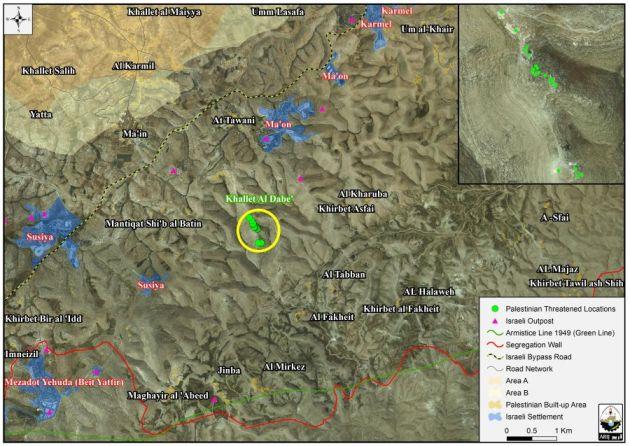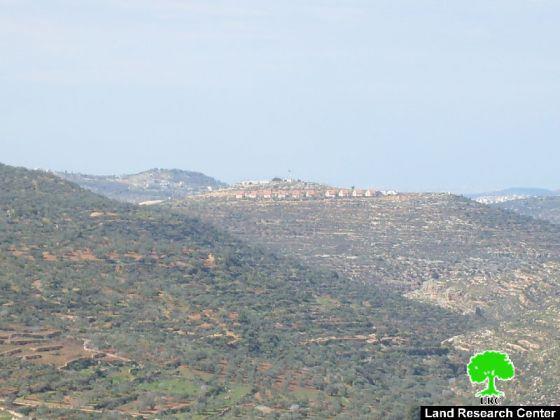On the 10th of July, 2013, the Israeli daily newspaper (Haaretz), published on its Hebrew website that the Deputy Supreme Court President, Miriam Naor, slammed the State Attorney’s decision for failing to abide by the proper civil procedure to respond to the petitions filed by 250 Palestinians who are at risk of eviction in the southern Hebron Hills, (designated as a “Firing or combat Zone” according to the Israeli military order number 271 of 1968).
Neor, criticized the state’s decision to respond to the petitions filed by the Palestinians by July 12, 2013, three days before the hearing session which is scheduled to be held on the 15 of July, 2013. Neor, in her statement, explained that State’s response to the petitions three days before the hearing session would leave the petitioners (the Palestinians) with no enough time to review the response of the state against the eviction of the communities. Neor insisted that the State to respond to the petitions by July 12 although the hearing scheduled on July 15 is cancelled but to be rescheduled after the court’s summer recess.
Evacuating Khallet Al-Dab’a (Al Dab’a Hamlet)
In a complementary procedure to what is happening in that area, Khallet Al-Dab’a (Al Dab’a Hamlet), located in southeast of Yatta town, south of Hebron, received on the 3rd of June, 20 military notifications from the Israeli Civil Administration office (ICA) stating the halt of construction at their structures under the pretext that the structures are situated in the area classified as “C according to OSLO II Interim agreement of 1995 [1], and designated as a “Firing or combat Zone 918” in 1968.. The targeted structures belong to: Abdallah Mahmoud Ibrahim Al-Dababseh, Badawi Muhammad Jabir Al-Dababseh, Su’oud Muhammad Jabir Al-Dababseh, Adnan Muhammad Jabir Al-Dababseh, Ali Muhammad Jabir, Najah Ahmad Abdallah Al-Dababseh. Table (1) below shows in details the targeted structures in Khallet Al-Dab’a:
Table 1: the targeted structures in Khallet Al Dab’a in the southern Hebron Hills
|
Military orders
|
The targeted structure
|
|
|
A toilet made out of zinco (1 sqm²).
|
|
|
A tent constructed on a concrete floor of 20 sqm² area.
|
|
|
An iron residential structure of 15 sqm² area.
|
|
|
A water well with a concrete opening.
|
|
|
A 1sqm² toilet.
|
|
|
A concrete residential structure surrounded with zinc of 20 sqm² area.
|
|
|
A zinc residential structure of 30 sqm² area.
|
|
|
A concrete residential structure of 5 sqm² area.
|
|
|
A water well with a concrete opening
|
|
|
A 15 sqm² concrete animal shed
|
|
|
A 35 sqm² concrete residential structure.
|
|
|
A 10 sqm² concrete residential structure.
|
|
|
1.5 sqm² concrete toilet
|
|
|
A 25 sqm² residential structure.
|
|
|
A Toilet made out of zinc (1 sqm²)
|
|
|
Blocks constructed on a cement floor (10 sqm²)
|
|
|
A residential structure with a zinc roof
|
|
|
An iron roof (30 sqm²)
|
|
|
A water well and a concrete opening.
|
|
|
Water Collection system, concrete roof (12 sqm²)
|
Source: ARIJ field team, 2013
Note that the Israeli Occupation Army (certainly with the Israeli government’s consent) continuously targets the residential structures in Khallet Al Dab’a and the surrounding communities in the southern Hebron hills with the pretext that they are located in a firing zone area; however, the Israeli practices in the area aim at providing “full security” to the Israeli settlers residing in the near settlements and outposts,such as Ma’on settlement, Mitzpe Ya’er and Avigal outposts.
The so-called “Firing Zone 918”
The area designated by the IDF as “Firing Zone 918” is located in the South Hebron Hills near the town of Yatta. Spread over 30,000 dunums and home to approximately 1,300 people, the area is comprised of 12 Palestinian communities, they are:Tuba, Mufaqara, Sfai, Majaz, Tabban, Fakheit, Megheir Al-Abeid, Halaweh, Mirkez, Jinba, Khallet Al-Dab’a and Sarura. Eight of these villages, with around 1,000 residents, currently face eviction.
Khallet Al-Dab’a, general glance
Khallet Al Dab’a (Al Dab’a Hamlet) is located southeast of Yatta town, south of Hebron. The hamlet is surrounded by two illegal Israeli outposts, Avigal and Mizpe Ya’ir, from the north and northwest respectively, and a few kilometers away from Ma’on settlement in the northwest, and an Israeli military base nearby. More than 55 Palestinians live in Khallet Al Dab’a and depend much on agriculture and livestock for their living.
Previous violations by the Israeli occupation
Khallet Al Dab’a has suffered from various Israeli violations in the previous years, where the latest one occurred on March 7, 2013, when the Israeli Authorities raided Khallet Al Dab’a and handed over demolition notices to Palestinian families living in that area targeting 24 structures under the pretext of ‘building illegally’ in the area classified as ‘C’, and located in the designated area “Firing Zone 918”. For more information about this case, follow this link: https://poica.org/editor/case_studies/view.php?recordID=6038
Analysis
The implicit and obvious ideology of the Israeli right-wing government demands the expulsion of the Palestinians, the destruction of their houses and the looting of their lands (no matter what methods and pretexts are used), in order to devote them for its colonial enterprise. This is exactly what is happening in Hebron southern hills since the issuance of the Israeli military order number 271 in 1968, which designated the southern Hebron hills along with other areas in the West Bank as “Firing or combat Zones” and the military order number 378 of 1970 which also declared the area as “Closed Military Zone” to prohibit Palestinian building and development in the area..
Today, Palestinians who live in the southern Hebron hills are considered by Israel as “illegal residents” and therefore they have to be expelled from their home lands despite the fact that they have been living in the area there even before the Israeli occupation of the Palestinian territory in 1967.
While the Palestinians throughout the West Bank suffer from Israel’s practices (land confiscations, house demolitions and restrictions of movement), the Israeli settlers, certainly, live in “full security”, because somehow they are certain that their state is fully backing them no matter what it takes. Full of deceits, falsehoods and discriminations, these are the standards of the so claimed “the only democratic state in the Middle East”, Israel.
To Conclude:
The Israeli occupation practices against the Palestinians of Khallet Al-Dab’a are an actual evidence of the continuous Israeli ethnic cleansing policy to expel and eradicate the Palestinians from their own land. However, these actions have been condemned over and over from the International law and human right conventions, some of which are listed below:
- Article 53 & 147 of the Fourth Geneva Convention of 1949 indicated that: Extensive destruction and appropriation of property not justified by military necessity and carried out unlawfully and wantonly, is a grave breach of the Convention.
- Moreover Art. 23 of the Hague Convention of 1907 also provides: In addition to the prohibitions provided by special Conventions, it is especially forbidden to destroy or seize the enemy’s property, unless such destruction or seizure be imperatively demanded by the necessities of war.
- Also under the Universal Declaration of Human Rights adopted and proclaimed by General Assembly resolution 217 A (III) of, December 10, 1948, Article 17 reads: ‘No one shall be arbitrarily deprived of his property.’ Which means it bans Israel from destroying or confiscating the property of the Palestinians at any case.
- ‘Article 12’ of the International Covenant on Civil and Political Rights Everyone lawfully within the territory of a State shall, within that territory, have the right to liberty of movement and freedom to choose his residence.
- Article 13 of the Universal Declaration of Human Rights,: Everyone has the right to freedom of movement and residence within the borders of each State.
- In the year 2004 the United Nations Security Council called on Israel to stop demolition of Palestinian homes under Resolution No. 1544-(2004), the resolution states: ‘The Security Council called on Israel to respect its obligations under international humanitarian law, particularly the obligation not to undertake home demolitions contrary to that law’
[1] Area C: Under the OSLO II Interim agreement of 1995, Israel retains full control over the administrartive and security matters.














